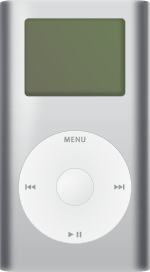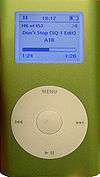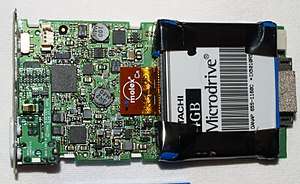iPod Mini
The iPod Mini (stylized and marketed as the iPod mini) is a digital audio player that was designed and marketed by Apple Inc. While it was sold, it was the midrange model in Apple's iPod product line. It was announced on January 6, 2004 and released on February 20 of the same year.[1][2] A second generation version was announced on February 23, 2005 and released immediately.[3] While it was in production, it was one of the most popular electronic products on the market,[4] with consumers often unable to find a retailer with the product in stock.[4] The iPod Mini was discontinued on September 7, 2005 and was replaced by the iPod Nano.[5][6]
 iPod Mini in Silver | |
| Manufacturer | Apple Inc. |
|---|---|
| Product family | iPod |
| Type | Digital audio player |
| Lifespan | February 20, 2004 – September 7, 2005 (1 year, 6 months) |
| Media | Microdrive hard drive (either 4 or 6 GB) |
| Operating system | 1.4.1 |
| Display | 1.67" monochrome LCD at 138 x 110 pixels |
| Input | Click wheel |
| Connectivity | USB 2.0 FireWire Dock connector Remote connector |
| Power | Lithium-ion battery |
| Successor | iPod Nano |
| This article is part of a series on the |
| iPod |
|---|
| List of iPod models |
The iPod Mini used the touch-sensitive scroll wheel of the third generation iPod. However, instead of the four touch buttons located above the wheel, the buttons were redesigned as mechanical switches beneath the wheel itself—hence the name click wheel. To use one of the four buttons, the user physically pushes the edge of the wheel inward over one of the four labels. Like its predecessors, the wheel was developed for Apple by Synaptics. The click wheel is now also used in the fourth, fifth and sixth generation iPods and the iPod Nano, from first generation through the fifth; however, in the Nano and 5G iPods onwards, the click wheel used was developed by Apple.
Above the wheel was a monochrome 138x110 LCD that displayed a menu or information about the selected track. Newer-generation iPods have since adopted color displays.
Models
| Model | Image | Capacity | Colors | Connection | Original release date | Minimum OS to sync | Rated battery life (hours) |
|---|---|---|---|---|---|---|---|
| 1st generation |  |
4 GB |
|
USB or FireWire | February 20, 2004 | Mac: 10.1.5 or later[7] Windows: 2000 iTunes 4.6 or later |
audio: 8 |
| New smaller model, available in 5 colors. Introduced the "Click Wheel". | |||||||
| 2nd generation |  |
4 GB |
|
USB or FireWire | February 23, 2005 | Mac: 10.2.8 or 10.3.4 or later[7] Windows: 2000 iTunes 4.7 or later |
audio: 18 |
| 6 GB | |||||||
| Brighter color variants with longer battery life. Click Wheel lettering matched body color. Gold color discontinued. Later replaced by the iPod Nano. | |||||||
Details
The two generations of iPod Mini were almost identical in their external features, except for two noticeable differences: the first generation model has gray control symbols on the click wheel, while those on the second generation matched the color of the body, and the player's storage capacity was etched on the back of the second generation body. Their major functional differences lay in their storage capacity and battery life. Both versions were 3.6x2.0x0.5 inches (91x51x13 mm) and weigh 3.6 ounces (102 grams). The case consists of anodized aluminium. First generation iPod Minis were available in five colors: silver, gold, pink, blue, and green. The gold model was dropped from the second generation range, likely due to its unpopularity. The pink, blue, and green models had brighter hues in the second generation; the silver model remained unchanged.
The iPod Mini used Microdrive hard drives (CompactFlash II) made by Hitachi and Seagate. First generation models were available in a 4 GB size, while second generation models were available in both 4 GB and 6 GB versions (quoted as capable of storing roughly 1,000 and 1,500 songs, respectively) and eventually the second generation had the capacity laser etched into the aluminum case.

The battery life of the first generation of iPod Mini was about 8 hours, similar to the third generation iPod that was available when the Mini was released, which some criticised for its short duration.[8] Apple addressed this problem in the second generation models, which had a nominal battery life of about 18 hours. However, the second generation iPod Minis no longer came with a FireWire cable or an AC power adapter, which were left out to reduce the selling prices of the new iPod Minis. iPod Mini batteries, like many Lithium Ion batteries, run down to 80% capacity after 400 full charge cycles.[9] A proprietary dock connector was provided on the bottom of the device for a connection to a computer's USB or FireWire port. The unit's battery could be charged during connection. Along the top it had a hold switch, a headphone jack, and a remote connector for accessories.
Like the iPod Nano, the iPod Mini supported MP3, AAC/M4A, WAV, AIFF, and Apple Lossless audio formats. It also retained the iPod's integration with iTunes and the iTunes Store, allowing for syncing between the software application and the iPod Mini.
Modification
Soon after the release of the iPod Mini, third party replacement batteries have been made available because its capacity decreases over time. There are various manuals for battery replacement on the internet and many outlets selling compatible Lithium-ion batteries for those who wish to avoid the expensive charge for sending the iPod back to Apple. Many such batteries are of higher capacity than the original – some are up to 2000mAh while the stock battery is 450mAh.[10]
The iPod Mini could be flashed to run iPodLinux or Rockbox firmware which has support for extra codecs, games and various other plugins and allowed music placed directly on the iPod to be played without using iTunes. Users have replaced the 4 or 6 GB Microdrive with high capacity 8, 16,[11] 32, 64 and even 256 GB CompactFlash cards. Aside from increased capacity, this has the advantage of increasing battery life and making the Mini more durable since CompactFlash cards are solid-state with no moving parts.
iPod Nano
On September 7, 2005, Apple released the first generation iPod Nano.[6] The Nano used flash memory to accomplish an even thinner casing, and featured a color screen. The headphone jack was moved to the bottom of the device, the dock connector shifted-off center, and the 4-pin remote connector was removed, among other changes. This caused the iPod Mini to be replaced by the iPod Nano.
Timeline of compact iPod models

| Wikimedia Commons has media related to iPod mini. |
References
- Inc., Apple. "Apple - Press Info - Apple Introduces iPod mini". www.apple.com. Archived from the original on July 9, 2011. Retrieved September 27, 2016.
- Inc., Apple. "Apple - Press Info - Apple Ships New iPod mini". www.apple.com. Archived from the original on August 6, 2011. Retrieved September 27, 2016.
- Inc., Apple. "Apple - Press Info - Apple Unveils New iPod mini Starting at Just $199". www.apple.com. Archived from the original on July 9, 2011. Retrieved September 27, 2016.
- "supply shortages in Walmart: iPod Mini 2G, iPod Classic" - 2004 Walmart Announcement
- peestandingup (February 13, 2006), Apple Music Special Event 2005-The iPod Nano Introduction, retrieved September 27, 2016 YouTube
- Inc., Apple. "Apple - Press Info - Apple Introduces iPod nano". www.apple.com. Archived from the original on July 9, 2011. Retrieved September 27, 2016.
- "The differences between iPod mini and iPod mini (Second Generation)". Apple. Archived from the original on March 8, 2013.
- TechFan. "Apple iPod Mini (4GB, Silver, first generation) MP3 player reviews – CNET Reviews". Cnn-cnet.com.com. Archived from the original on July 19, 2012. Retrieved November 29, 2011.
- Apple Inc. (March 26, 1999). "Apple Canada – Batteries – iPod". Apple.com. Archived from the original on July 9, 2004. Retrieved November 29, 2011.
- "EC003 Battery". Complete Battery Source. Retrieved August 7, 2020.
- turn your iPod mini into a flash based iPod :: projects :: geek technique, retrieved January 30, 2014
- Apple Inc., Apple press release library, Retrieved September 19, 2007.
- Mactracker (mactracker.ca), Apple Inc. model database, version as of July 26, 2007.